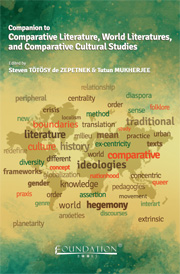Book contents
- Frontmatter
- Contents
- Introduction to the Companion to Comparative Literature, World Literatures, and Comparative Cultural Studies
- PART 1 Theories of Comparative Literature, World Literatures, and Comparative Cultural Studies
- The Contextual Study of Literature and Culture, Globalization, and Digital Humanities
- Comparative Literature and Ex-centricity
- Possibilities and Limits of Comparative Literature Today
- Comparative Cultural Studies and Pedagogy
- Teaching World Literatures
- Comparative Literature and the History of Literature
- Meltzl de Lomnitz, Comparative Literature, and Philosophy
- Comparative Cultural Studies and Cultural Anthropology
- Comparative Literature and Interart Studies
- Gender and Genre in Comparative Literature and (Comparative) Cultural Studies
- Comparative Cultural Studies and Translation Studies
- Comparative Cultural Studies and the Study of Medieval Literature
- Comparative Cultural Studies and Linguistic Hybridities in Literature
- Comparison and Postcoloniality
- (Inter)mediality and the Study of Literature
- PART 2 Comparative Literature in World Languages
- PART 3 Examples of New Work in Comparative Literature, World Literatures, and Comparative Cultural Studies
- PART 4 Multilingual Bibliography of Books in Comparative Literature, World Literatures, and Comparative Cultural Studies
- Index
Possibilities and Limits of Comparative Literature Today
from PART 1 - Theories of Comparative Literature, World Literatures, and Comparative Cultural Studies
Published online by Cambridge University Press: 05 April 2014
- Frontmatter
- Contents
- Introduction to the Companion to Comparative Literature, World Literatures, and Comparative Cultural Studies
- PART 1 Theories of Comparative Literature, World Literatures, and Comparative Cultural Studies
- The Contextual Study of Literature and Culture, Globalization, and Digital Humanities
- Comparative Literature and Ex-centricity
- Possibilities and Limits of Comparative Literature Today
- Comparative Cultural Studies and Pedagogy
- Teaching World Literatures
- Comparative Literature and the History of Literature
- Meltzl de Lomnitz, Comparative Literature, and Philosophy
- Comparative Cultural Studies and Cultural Anthropology
- Comparative Literature and Interart Studies
- Gender and Genre in Comparative Literature and (Comparative) Cultural Studies
- Comparative Cultural Studies and Translation Studies
- Comparative Cultural Studies and the Study of Medieval Literature
- Comparative Cultural Studies and Linguistic Hybridities in Literature
- Comparison and Postcoloniality
- (Inter)mediality and the Study of Literature
- PART 2 Comparative Literature in World Languages
- PART 3 Examples of New Work in Comparative Literature, World Literatures, and Comparative Cultural Studies
- PART 4 Multilingual Bibliography of Books in Comparative Literature, World Literatures, and Comparative Cultural Studies
- Index
Summary
Abstract: In his article “Possibilities and Limits of Comparative Literature Today” Darío Villanueva discusses the itinerary of comparative literature and its problematics and queries the discipline's adherence to literary history and its identification with the theory of literature. Villanueva's discussion is with particular reference to Spanish-language works such as by Claudio Guillén's systemic view of literature and the study of literature, as well as similar approaches to the study of literature such as by Siegfried J. Schmidt, Itamar Even-Zohar, and Steven Tötösy de Zepetnek. Further, Villanueva discusses aspects of the field of (comparative) cultural studies he sees relevant and useful for the study of literature comparatively.
In an attempt to abandon the identification of genetic relationships to justify comparativist research, the last twenty-five or thirty years have seen the emergence of a new paradigm of comparative literature. A basic principle of the new paradigm is that whenever the same or a similar phenomenon appears in two separate literatures or in one literature and in another type of artistic expression, the comparative approach must include a fundamental theoretical element, that is to say, a possible or hypothetical point of departure. The immediate consequence of such an approach is comparative literature's if not exclusive, then at least preferential link with literary theory (see Fokkema 3). Thus, since the 1970s, roughly, comparative literature developed with a theoretical component and that gave the discipline its innovative character.
- Type
- Chapter
- Information
- Companion to Comparative Literature, World Literatures, and Comparative Cultural Studies , pp. 49 - 62Publisher: Foundation BooksPrint publication year: 2014



